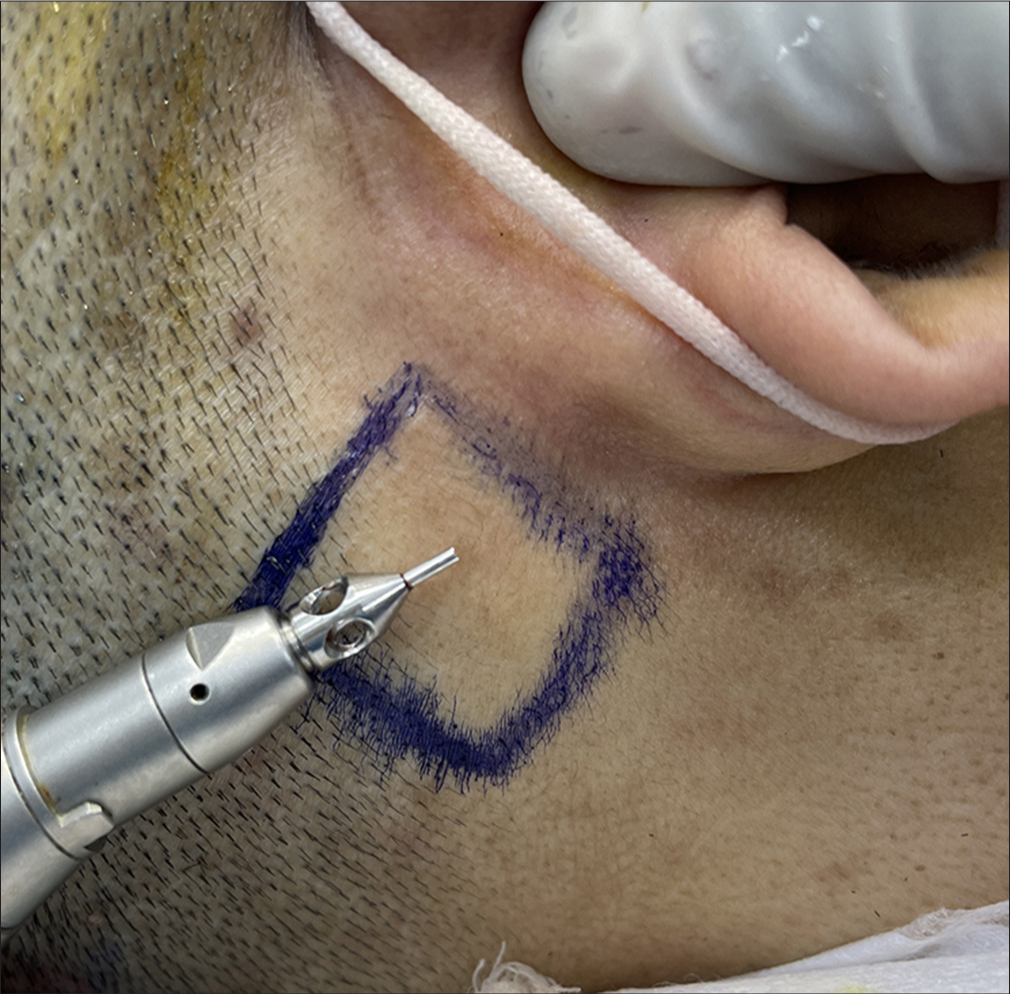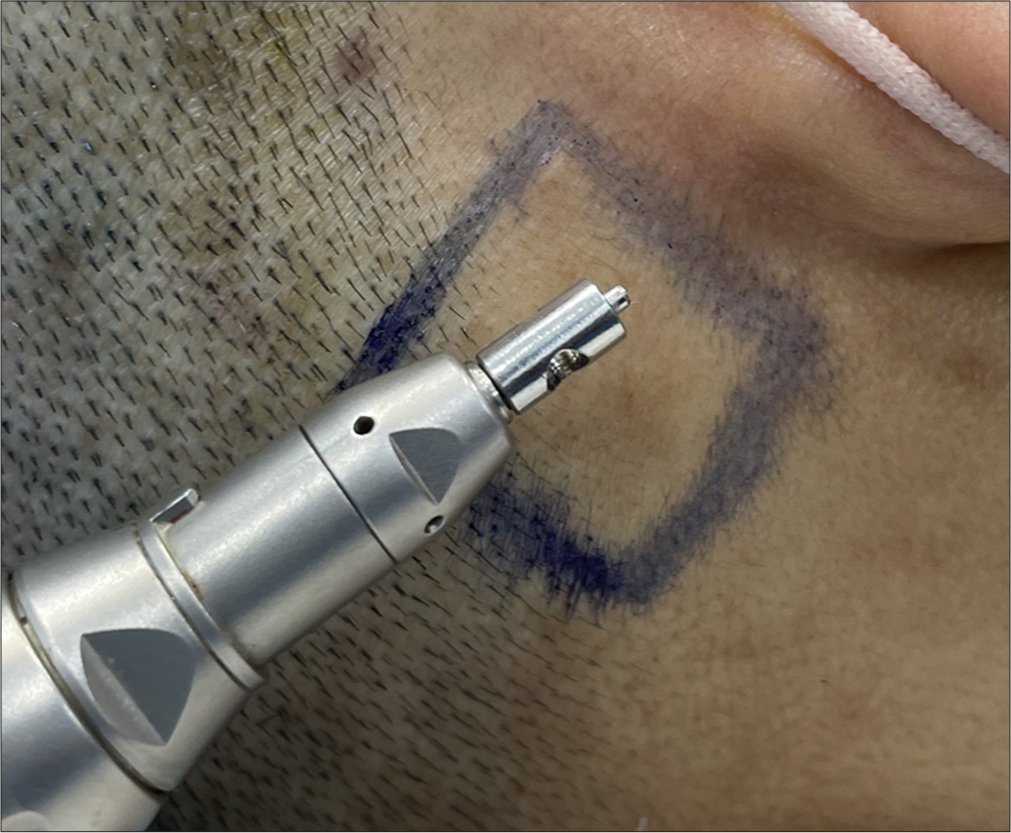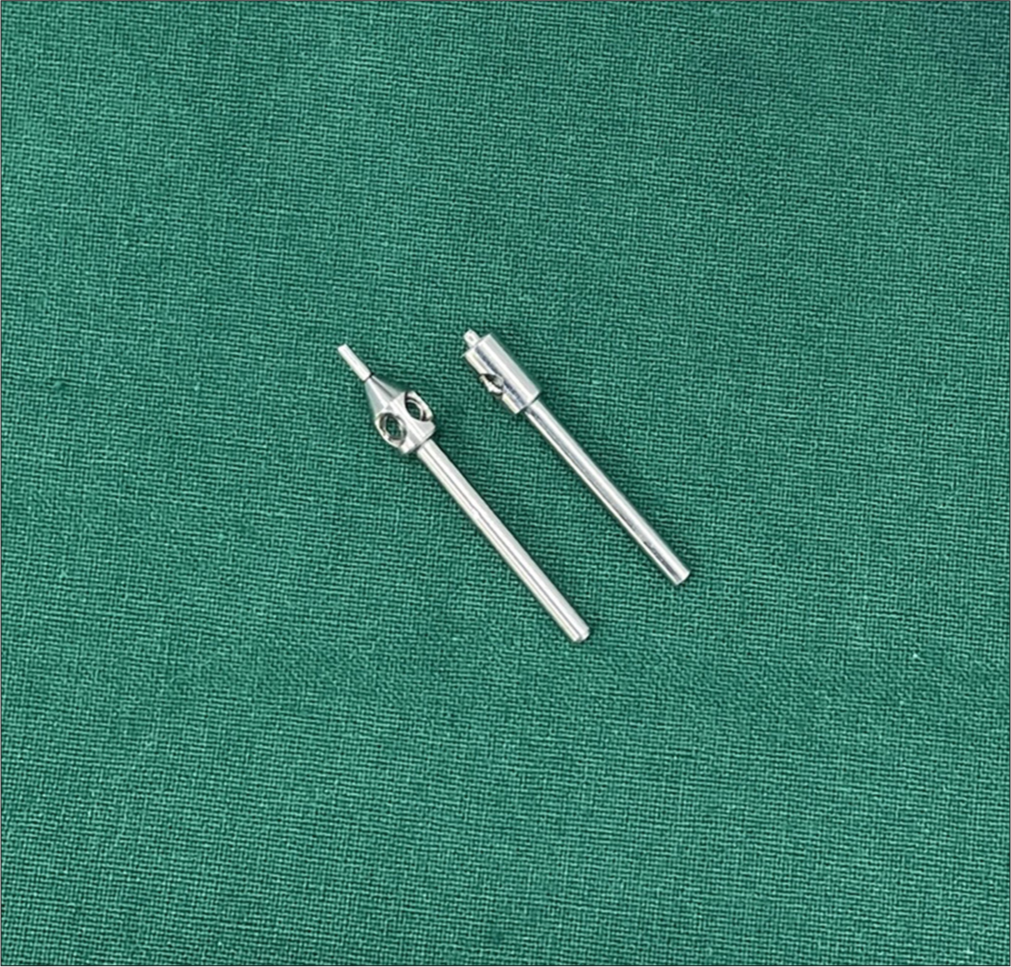Translate this page into:
Customized short punches for mini punch grafting in vitiligo
*Corresponding author: Dr. Sonia Parsram Sabhandasani, MBBS, MD Dermatology, Consultant at Dr Sonia’s Clinic, Maharashtra, India. soniasabhandasani.92@gmail.com
-
Received: ,
Accepted: ,
How to cite this article: Kerure AS, Ghia DH, Sabhandasani SP, Salim T. Customized short punches for mini punch grafting in vitiligo. J Cutan Aesthet Surg. 2025;18:63-5. doi: 10.25259/JCAS_144_2024
Abstract
Vitiligo, a chronic skin disorder characterized by depigmented patches, often presents challenges in management due to the unpredictable nature of repigmentation. Mini punch grafting, a surgical technique, is a widely accepted treatment for stable vitiligo. This article focuses on the innovative use of customized short punches in mini punch grafting. The aim is to provide insights into their advantages, the customization process, and their role in improving outcomes for vitiligo patients.
Keywords
Customized short punches
Mini punch grafting
Repigmentation
Surgical treatment
Vitiligo
PROBLEM STATEMENT
Vitiligo is a result of disrupted epidermal melanization with an undecided etiology and incompletely understood pathogenesis.1 Among the commonly employed surgical techniques for vitiligo, tissue grafting methods have gained significant attention for their effectiveness in stable cases. The most widely used techniques include Thin Thiersch’s grafting, suction blister grafting, punch grafting, and mini punch grafting (MPG).2 Stable vitiligo, where disease progression has halted for at least a year, is a prime candidate for surgical interventions such as MPG. MPG involves the transplantation of small, full-thickness skin grafts from normally pigmented areas to depigmented patches.
Follicular unit extraction (FUE) punches are specialized surgical instruments primarily used in hair transplantation but also adapted for vitiligo surgery, especially in procedures like MPG. The procedure involves harvesting tissue, typically from concealed areas such as the upper thigh or gluteal region. This is done using a punch biopsy tool fitted with a blade, which extracts a cylindrical core of tissue. The process can be performed either manually or with the assistance of a motorized device. The traditional use of punches, ranging from 1.5 mm to 2 mm in length [Figure 1] has shown success in repigmentation but is not without limitations. Cobblestoning, variegated appearance and color mismatch, static graft, depigmentation of graft, perigraft halo, and graft rejection are complications at the recipient site, and hypertrophic scars and depigmentation are complications at the donor site.2

- Standard follicular unit extraction punches with longer length.
The introduction of customized short punches offers a potential solution by addressing these limitations while enhancing the precision and efficacy of the procedure.
RECOMMEMDED SOLUTION
Punch grafting involves the extraction and transplantation of small circular grafts of pigmented skin, typically harvested using biopsy punches measuring 2–3 mm in diameter and 1.5–2 mm in length.2
We propose using customized short punches that are specifically designed to optimize graft harvesting and placement. The customization of punches involves modifying the standard instruments to produce shorter, more precise punches suited to the delicate nature of MPG in vitiligo. The punches have diameters ranging from 0.9 mm to 2 mm, allowing for precise extraction of small, uniform skin grafts. The length of each punch is limited to 0.5–1.5 mm, [Figure 2] ensuring extraction of only the topmost layers of the skin (epidermis and superficial dermis), which minimizes donor-site trauma while ensuring optimal graft quality and successful repigmentation. Shorter punches also prevent deeper-than-needed cuts, minimizing trauma to the surrounding tissue and reducing the risk of visible scarring at the donor site, which is particularly important when donor areas are exposed or esthetically significant (e.g., face and forearms).

- New modified punches with shorter length.
The punches are made from high-grade, sterilizable stainless steel, ensuring durability and sharpness throughout the procedure [Figure 3].

- The difference between both the punches.
To enhance efficiency, these customized punches are designed with motorized assistance. When attached to a motorized device, the punches significantly reduce the time required for both graft harvesting and recipient site preparation, making the procedure faster and less labor-intensive for the surgeon. This motorized option improves consistency, and the precise, shallow punches ensure better integration of grafts by perfectly fitting into recipient sites, thus reducing the risk of complications such as cobblestoning or graft failure.
Employing advanced tools like customized punches helps surgeons stay at the forefront of medical innovation, offering cutting-edge treatments to patients. The use of customized short punches can help surgeons refine their technique with more precise tools, leading to improved outcomes and higher patient satisfaction, which would elevate a surgeon’s confidence in performing vitiligo surgery [Table 1].
| Aspect | FUE punches | Modified short punches |
|---|---|---|
| Length of the punch | Longer punches designed for deeper tissue access (1.5–2 mm) | Shorter punches for superficial tissue sampling (0.5–1.5 mm) |
| Depth control | Requires manual or motorized adjustment for depth precision | Naturally limits depth, reducing the risk of over-harvesting |
| Grafts of different length | Can harvest grafts of varying lengths for diverse needs | Best suited for shorter grafts with limited length variation |
FUE: Follicular unit extraction
Short comings of short punches
High cost: Short punches are more expensive, and their use often increases the overall procedure cost
Skill and equipment dependency: They need motorized tools and expert training, making them harder to use in low-resource setups.
Authors’ contributions
Dr. Amit Kerure: Conceived and designed the analysis. Collected the data. Dr. Dipti Ghia: Contributed data and analysis. Dr. Sonia Sabhandasani: Collected the data, wrote the paper. Dr. T. Salim: Collected the data and analysis.
Ethical approval
Institutional Review Board approval is not required.
Declaration of patient consent
The authors certify that they have obtained all appropriate patient consent.
Conflicts of interest
There are no conflicts of interest.
Use of artificial intelligence (AI)-assisted technology for manuscript preparation
The authors confirm that there was no use of artificial intelligence (AI)-assisted technology for assisting in the writing or editing of the manuscript and no images were manipulated using AI.
Financial support and sponsorship: Nil.
References
- Evolution and evaluation of autologous mini punch grafting in vitiligo. Indian J Dermatol. 2009;54:159-67.
- [CrossRef] [PubMed] [Google Scholar]
- Autologous mini punch grafting: An experience of using motorized power punch in 10 patients. J Cutan Aesthet Surg. 2014;7:42.
- [CrossRef] [PubMed] [Google Scholar]






